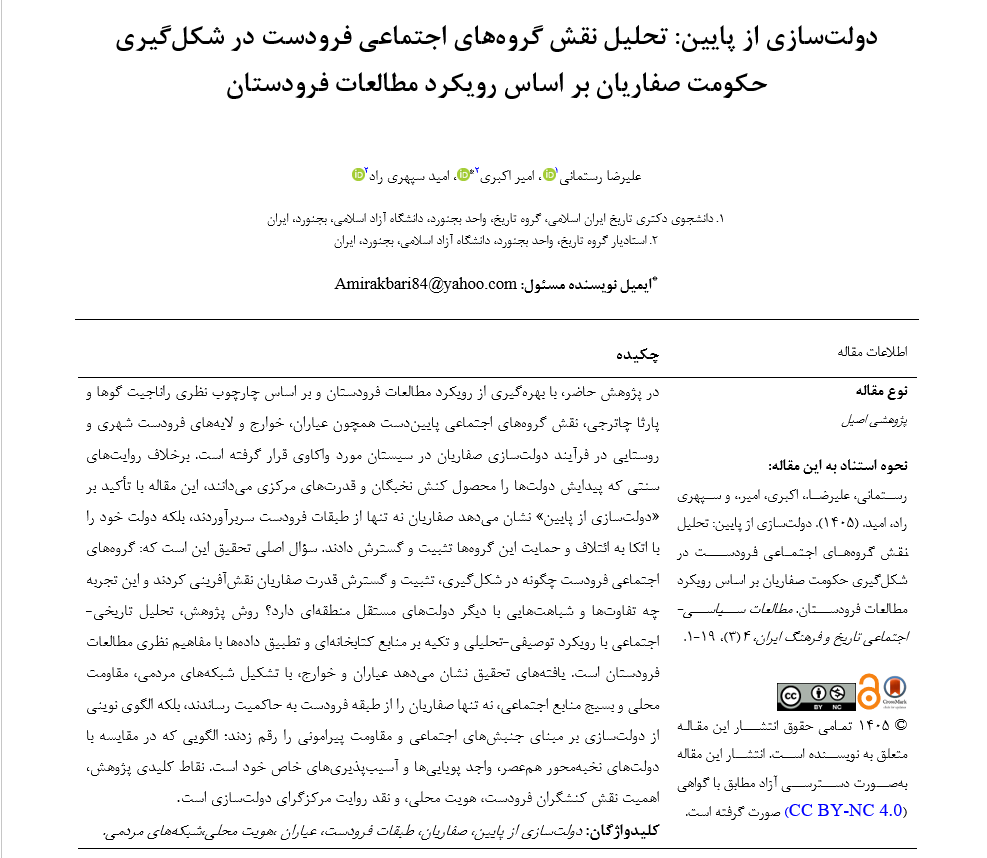State-Building from Below: An Analysis of the Role of Subaltern Social Groups in the Formation of the Saffarid Government Based on the Subaltern Studies Approach
Keywords:
State-building from below, Saffarids, Subaltern classes, Ayyaran, Local identity, Popular networks.Abstract
In this study, using the framework of Subaltern Studies and based on the theoretical perspectives of Ranajit Guha and Partha Chatterjee, the role of lower social groups such as ayyars (urban militias), Kharijites, and subaltern urban and rural strata in the process of Saffarid state formation in Sistan is examined. Contrary to traditional narratives that view the emergence of states as the product of elite actions and central powers, this article—emphasizing the concept of “state-building from below”—demonstrates that the Saffarids not only emerged from subaltern classes but also consolidated and expanded their rule through the coalition and support of these groups. The main research question is: how did subaltern social groups contribute to the formation, consolidation, and expansion of the Saffarid power, and what similarities and differences can be observed between this experience and other contemporary regional independent states? The research method is a historical-sociological analysis with a descriptive-analytical approach, relying on library sources and correlating data with the theoretical concepts of Subaltern Studies. The findings indicate that the ayyars and Kharijites, by forming popular networks, local resistance movements, and mobilizing social resources, not only elevated the Saffarids from subaltern strata to rulership but also established a new model of state-building based on social movements and peripheral resistance—a model that, compared to elite-driven contemporaneous states, possessed unique dynamics and vulnerabilities. The key points of the study emphasize the importance of subaltern actors, local identity, and the critique of centralist narratives of state formation.
Downloads
References
Abbasi, M. (2009). Local Identity in Sistan and the Saffarid State. Identity and Culture, 9(3), 35-54.
Bastani Parizi, M. E. (2004). Sistan in Iranian History. Elm.
Bosworth, C. E. (1994). The Saffarids of Sistan and the Sistan of the Saffarids. In The Cambridge History of Iran (Vol. 4, pp. 90-129). Cambridge University Press.
Bosworth, C. E. (2013). The Saffarids (Translated by G. Sahab ed.). Afshar Endowments Foundation.
Chatterjee, P. (2004). The Politics of the Governed: Reflections on Popular Politics in Most of the World. Columbia University Press.
Daniel, E. L. (1989). The Political and Social History of Khurasan under Abbasid Rule. Bibliotheca Islamica.
Dehbashi, H. (2015). The Culture of Resistance in Iran. Institute for Humanities and Cultural Studies.
Eskandari, Y. (2016). The Popular Legitimacy of the Saffarid State in Islamic Sources. Civilization Studies, 2(7), 15-32.
Farrokh, M. H. (2011a). Popular Movements and Local States in Iran. Ettela'at.
Farrokh, M. H. (2011b). Transformations in the Social Structure of Sistan in the Saffarid Era. Human Sciences Research Journal, 2(3), 65-85.
Fayyaz, I. (2016). Social Capital in Iran. Research Institute of Culture, Art, and Communication.
Ghaderi, I. (2019). The Kharijites of Sistan and Their Impact on the Social Transformations of the Saffarid State. Islamic History and Iran, 15(1), 33-52.
Ghanbari, Z. (2018). Local Democracy and the Role of the Subalterns in Iranian State-Building Before the Mongols. Institute for Humanities Research.
Guha, R. (1982). On Some Aspects of the Historiography of Colonial India. In Subaltern Studies I: Writings on South Asian History and Society. Oxford University Press.
Hobsbawm, E. J. (1959). Primitive Rebels: Studies in Archaic Forms of Social Movement in the 19th and 20th Centuries. Manchester University Press.
Jamshidi, H. (2021). Rereading the Social Capital Theory in Local State-Building of Sistan. Historical Sociology, 1(1), 43-61.
Jamshidi, J. (2021). The Subalterns and the State in Iranian History. Agah.
Karimi, M. J. (2019). The Ayyaran and the Structure of Local Power in Saffarid Sistan: A Comparative Study. Naqd-e Farhang.
Malayeri, M. (1993). The Sociology of the Ayyaran in Medieval Iran. Toos.
Modarresi Tabatabaei, S. J. (2001). Investigating the Role of the Kharijites in the Saffarid State. Historical Research Journal, 4(1), 75-91.
Moftakhari, M. (2000). The Kharijites and Their Role in the Transformations of the Early Islamic Centuries. Ney.
Mohammadkhani, A. (2022). Subaltern Studies and New Iranian Historiography. Ney.
Mousavi, A. (2021). Indigenous State-Building in Iran: A Case Study of the Saffarids of Sistan. Ferdowsi University of Mashhad.
Onsor al-Maali, K. i. I. (2004). Qabus-nameh (Corrected by G. H. Yousefi ed.). Kharazmi.
Ravandi, M. (2003). The Social History of Iran (Vol. 2). Amir Kabir.
Saberi, A. (2012). Investigating the Social and Political Grounds for the Emergence of the Saffarids Ferdowsi University of Mashhad].
Safa, Z. (1999). History of Iranian Literature (Vol. 1). Ferdous.
Samiee, R. (2014). A Comparison of Saffarid and Buyid State-Building. Islamic History Research Journal, 14(2), 87-104.
Scott, J. C. (1985). Weapons of the Weak: Everyday Forms of Peasant Resistance. Yale University Press.
Shojaei Saen, S. Z. S. (1997). A Sociological Analysis of the Saffarids. Islamic History and Iran(22), 35-50.
Taherkhani, H. (2013). Popular Resistance and the Role of Ayyaran Networks in Saffarid State-Building. Historical Research Journal, 8(2), 90-105.
Tajik, N. (2022). Rethinking Collective Identity and State-Building in Sistan: From Pre-Islamic Era to the Saffarids. Mahris.
Zarrinkoub, A. (2003). History of Iran After Islam. Amir Kabir.

Downloads
Published
Submitted
Revised
Accepted
Issue
Section
License
Copyright (c) 2025 علیرضا رستمانی (نویسنده); امیر اکبری; امید سپهری راد (نویسنده)

This work is licensed under a Creative Commons Attribution-NonCommercial 4.0 International License.







